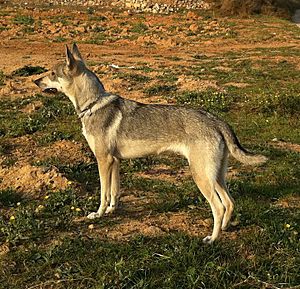Lobito Herreño facts for kids
 |
|||||||||||||||||||||||||
| Other names |
|
||||||||||||||||||||||||
|---|---|---|---|---|---|---|---|---|---|---|---|---|---|---|---|---|---|---|---|---|---|---|---|---|---|
| Origin | El Hierro, Canary Islands, Spain | ||||||||||||||||||||||||
| Breed status | Not recognised as a standardised breed by any major kennel club. | ||||||||||||||||||||||||
|
|||||||||||||||||||||||||
| Notes | listed among Grupos Étnicos Caninos by the Real Sociedad Canina de España | ||||||||||||||||||||||||
| Domestic dog (Canis lupus familiaris) | |||||||||||||||||||||||||
The Lobito Herreño (say: Loh-BEE-toh Eh-RREH-nyoh) is a special type of dog from El Hierro, one of the Canary Islands in Spain. Its name means "little wolf from El Hierro." This dog is a kind of pastoral dog, which means it traditionally helps shepherds with their sheep and other animals.
You can find most Lobito Herreño dogs on El Hierro. However, some also live on other Canary Islands like Gran Canaria, La Palma, and Tenerife.
Even though it's not officially recognized as a breed by the main Spanish dog club, the Real Sociedad Canina de España, it is considered a "canine ethnic group." This means it's a group of dogs from a certain area that look and act similarly because they've been chosen for specific jobs over time.
Contents
Discover the Lobito Herreño
The Lobito Herreño has a very old history. It's not fully clear if these dogs are related to dogs that lived on the Canary Islands before people from Castile arrived in the 1400s. Some experts think the Lobito Herreño might come from dogs brought to the islands around the 1700s or later.
In 2013, the Spanish dog club included the Lobito Herreño in its list of "canine ethnic groups." This was an important step towards recognizing them. They even published a first draft of what the breed standard should be like. A breed standard describes what a perfect dog of that breed should look like and act.
Protecting Island Dog Breeds
In 2021, the government of the Canary Islands decided that the main native animal breeds, including dogs, are an important "cultural, genetic, and ethnographic heritage." This means they are a valuable part of the islands' history and nature.
While four other well-known dog breeds from the Canary Islands were included in this declaration, the Lobito Herreño was not. However, its importance was discussed in the Parliament. There are other local dog types in the Canary Islands, like the Podenco Enano and the Ratonero Palmero, that are also seeking official recognition.
What the Lobito Herreño Looks Like
The Lobito Herreño looks a bit like a wolf, with a wild and ancient appearance. It's a medium-sized dog.
- Height: Males are usually about 54 cm (21 inches) tall at the shoulder, and females are about 52 cm (20 inches).
- Weight: Males typically weigh around 22 kg (48.5 pounds), and females weigh about 18 kg (40 pounds).
Their fur is usually grey, but it can also be reddish. Both colors often have lighter fur around their mouth and eyes, like a pale mask. Sometimes, they can be solid white or cream, and these dogs don't have the mask. The tip of their tail is always black.
How Lobito Herreños Help People
Traditionally, Lobito Herreño dogs were working dogs. They helped shepherds move and manage their flocks of sheep and goats. They were known for being wary of strangers but very loyal and faithful to their owners.
Today, fewer people work as shepherds. Because of this, the Lobito Herreño is becoming more popular as a companion dog. This means they are kept as pets and family members, rather than just for herding work.
See also
 In Spanish: Perro lobo herreño para niños
In Spanish: Perro lobo herreño para niños

